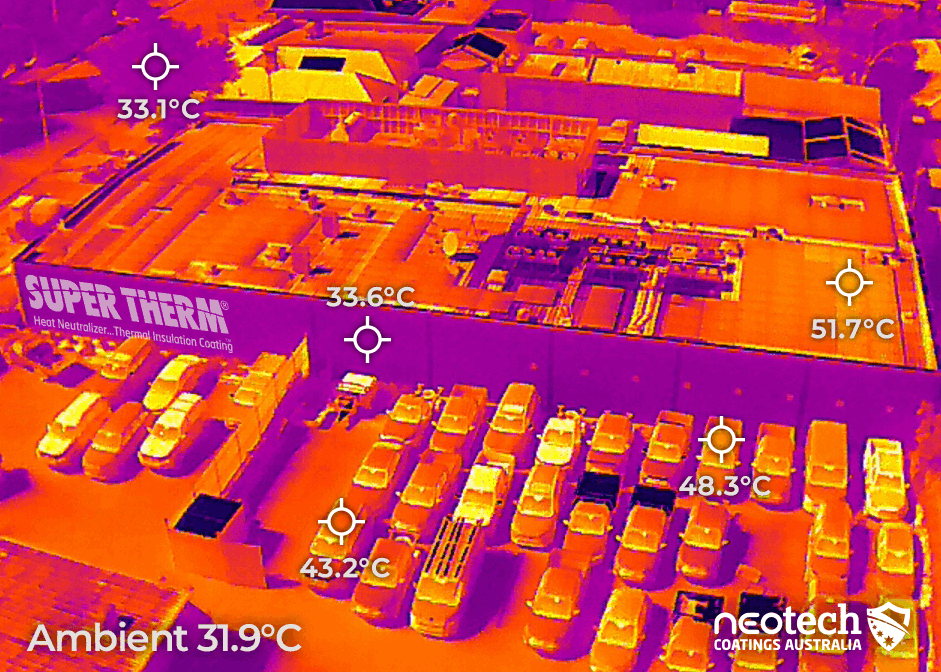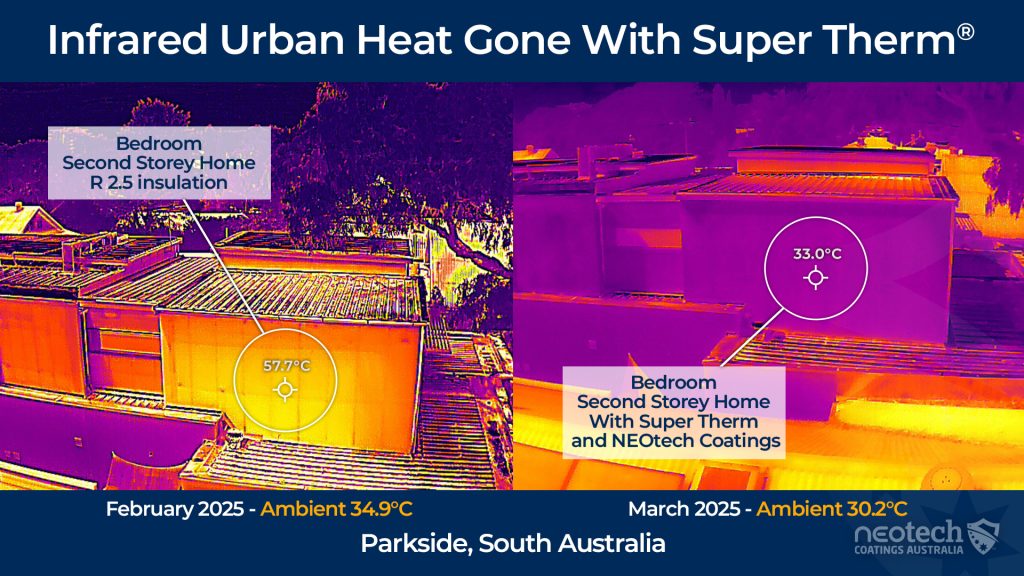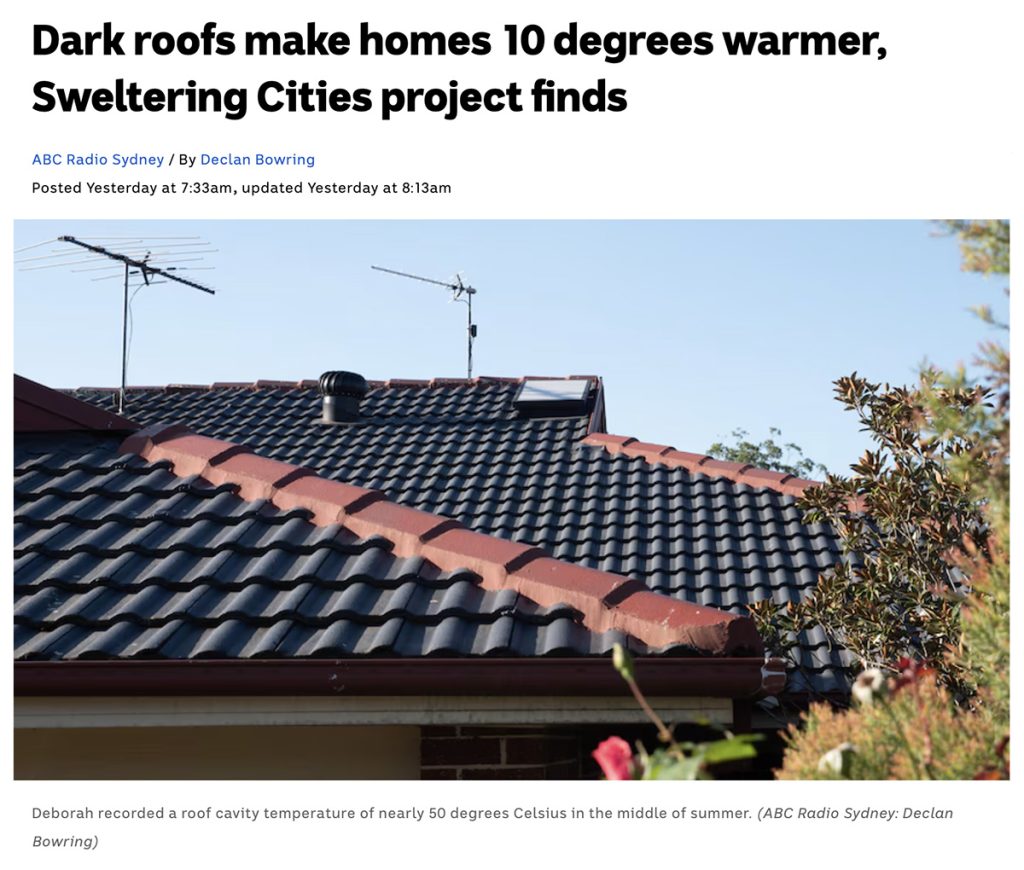Social Housing and the Need for Cool Roofs & Walls
Humans Can’t live in 40°C Heat
A UNSW Sydney research team’s technological and cost-benefit analyses of adopting cool roof technology across major Australian cities has found that city-wide implementation of cool roofs would:
- reduce energy bills
- lower indoor temperatures
- decrease urban heating
- improve the health of vulnerable populations.
A recent article by Abby Mellick Lopes, Associate Professor, Design Studies, Faculty of Design, Architecture and Building, University of Technology Sydney ‘When homes already hit 40°C inside, it’s better to draw on residents’ local know-how than plan for climate change from above’, highlighted the lack of ability for residents to keep cool.
Weather extremes driven by climate change hit low-income communities harder. The reasons include poor housing and lack of access to safe and comfortable public spaces. This makes “climate readiness” a pressing issue for governments, city planners and emergency services in fast-growing areas such as Western Sydney.
Residents and renters are sweltering through temperatures as hot as 40C in their homes, new research has revealed, with advocates saying the cost-of-living crisis is forcing people to live in unhealthy conditions. The World Health Organization’s recommended safe limit is no higher than 25C for more than nine hours a day. Despite lower temperatures in South Australia, renters spent more than nine hours a day above 25C on average and one recorded hitting 37.1C (source).
“I always heard stories of social housing being terrible, but I didn’t get how terrible they are. Living in poor-quality housing, there are health effects.”
Melika Jordan rents from a community housing provider in Newcastle
Simple Building Envelope Protection
The concept of a building envelope relates to design and construction of the exterior of the house. A good building envelope involves using exterior wall materials and designs that are climate-appropriate, structurally sound and aesthetically pleasing. These three elements are the key factors in constructing your building envelope. The building envelope of a house consists of its roof, sub floor, exterior doors, windows and of course the exterior walls.
Importantly virtually none of the surfaces mentioned that relate to the building envelope in Australia actually block the heat load or heat transfer. All materials absorb the heat then let it into the home or apartment through solar heat gain. Colour helps reduce the amount of visual light absorbed, however blocking the infrared heat will really make the difference. That’s where SUPER THERM® steps in…blocking 96.1% of the total solar heat.
Solar Heat Block on a Data Centre Wall…Reduce the risk with Super Therm®
Virtually none of the surfaces materials used in Australia that relate to the building envelope actually block the heat load or solar heat transfer.
As deaths from extreme weather increase, heat is the biggest killer. This is avoidable if houses and apartments had envelopes that protected them from intense solar heat gain. SUPER THERM® can do this. This is also conducive to poor mental health. As an example, a disability pensioner, Barbara Giardina lives in a public housing unit managed by South Australia’s Housing Authority. The single-storey unit shares a roof and wall with an adjoining unit. “The heat gets in through the brick, through the roof … it just gets the heat as long as the sun’s awake,” she said. Blocking the heat load will help people like Barbara and solve a major problem not being addressed in the new 7-star standards.

Impacts of Heat on our Society
Heatwaves, or heat and hot weather that can last for several days, can have a significant impact on society, including a rise in heat-related deaths. Heatwaves are among the most dangerous of natural hazards, but rarely receive adequate attention because their death tolls and destruction are not always immediately obvious. From 1998-2017, more than 166,000 people died due to heatwaves, including more than 70,000 who died during the 2003 heatwave in Europe (Source).
‘Stuck in the Heat – Lived Experiences of Public Housing Tenants in the Kimberley’
The extreme heat in the Kimberley is felt more by public housing tenants who face many barriers to coping with heat. Tenants struggle to keep temperatures down in poor quality housing, are under financial pressure as they try to afford air conditioners and power bills and they feel the impacts of heat stress on daily health and wellbeing. Findings include (Source):
- Poor quality public housing, maintenance issues and overcrowding due to low housing stock impacts the ability of public housing tenants to effectively control the temperature and energy efficiency of their homes.
- Public housing tenants in the Kimberley may experience energy poverty due to high energy prices and the use of inefficient cooling appliances – “Aboriginal people comprise 59 percent of tenants in social housing in the region”.
- Current Housing Authority cooling policy tends to reinforce the financial disadvantage experienced by many public housing tenants in the Kimberley – “There are no minimum standards relating to cooling in the Residential Tenancies Act”.
- The effects of the heat on social wellbeing are broad and impact employment, sleep, children’s health and therefore school attendance and antisocial behaviour.

Dependancy on Air Conditioners
In Australia, there is a growing dependence on mechanical air-conditioning to reduce the impact of heat stress. In March 2014, 74% of dwellings in Australia had coolers, up from 59% in 2005. However, this dependency on air-conditioning overloads the power grid and results in power outages during heatwaves as observed during 2009 and 2014 heatwaves in Melbourne and Adelaide. Therefore, it is crucial to ensure that the dwellings are thermally comfortable in the absence of air-conditioning during a heatwave period (Source).
Study by UniSA into Cool Roofs into Power Consumption
Dr John Pocket of the University of South Australia wrote a document called ‘Cool Roofs and Heat Reflective Paints’. He undertook a study to understand surface reflectance effects while doing work for a National Climate Change Adaptation Research Facility report. Minimising roof surface temperatures increases and means the roof insulation system becomes less critical.
Peak electricity loads during hot spells where, in South Australia, about 23 hours per year contributed to 45% of wholesale generation costs. It feeds through to South Australian residents paying higher rates in Australia. Additional to generation costs, more distribution and transmission capital expenditure has to be recouped over a number of years, increasing bills. It is also very common in Australia for insulation to be extremely poorly installed.
Cooling efficiency is much less than heating and falls off very quickly as the ambient temperature increases, being about half its maximum when we have a very hot day. This requires much more electricity to get the same cooling effect and is one of the reasons why our modelling shows more effect for light rather than dark roofs compared with modelling based only on the first step, heat flow into conditioned spaces. This is for fixed speed air conditioners.
Inverter systems are thermally less efficient. Research done at UniSA has shown that even very conservatively sized air conditioning should not need any more than a peak rating of 90 W/m2. It is better not to have the air conditioner idling as the Coefficient of Performance (CoP) falls markedly. It is a bit like idling the engine of a car at traffic lights in that a lot of petrol is used but you aren’t travelling far.
Living with Urban Heat: Becoming Climate-Ready in Social Housing
This project aims to address liveability in rapidly warming cities by focusing on the role that social practice plays in complementing technical and infrastructural cooling solutions. This project expects to generate new knowledge about equitable heat adaptive practices. It does so by working with culturally diverse social housing residents using an innovative blend of participatory action research and transition design.
Expected outcomes of this project include practical, low-cost cooling strategies that can be implemented now, along with increased social input into planning for the hotter urban future. This should provide significant benefits, such as enhanced civic capacity to generate society-wide climate readiness. The project is a collaboration with social housing providers Bridge Housing , Link-Wentworth, and St. George Community Housing and advocacy organizations Faith Housing Alliance and UCA-Parramatta Nepean Presbytery and the communities they serve. Western Sydney University.
Related Articles:
- Dark roofs make homes 10 degrees warmer, Sweltering Cities project finds
- This summer it reached 39 degrees inside Charles’s rental home
- When homes already hit 40°C inside, it’s better to draw on residents’ local know-how than plan for climate change from above
- Heatwave highlights struggle for public housing tenants in Mildura without air conditioning
- REPORT: ‘Stuck in the Heat – Lived Experiences of Public Housing Tenants in the Kimberley’
- Social housing temperatures in NSW exceed health and safety limits: study
Research Papers:
- Social and Emotional Wellbeing impacts of prolonged extreme heat driven by climate change: lived experiences of public housing residents in a regional community in Victoria, Australia
- Disproportionately higher exposure to urban heat in lower-income neighborhoods: a multi-city perspective
Challenges of Lower Income:
- Urban Heatwaves Are Worse For Low-Income Neighborhoods
- Heat and smog hit low-income communities and people of color hardest, scientists say
- Low-income areas shown to experience hotter temperatures in L.A. county
- Caltech finds heat disparity between low-income neighborhoods, affluent areas










